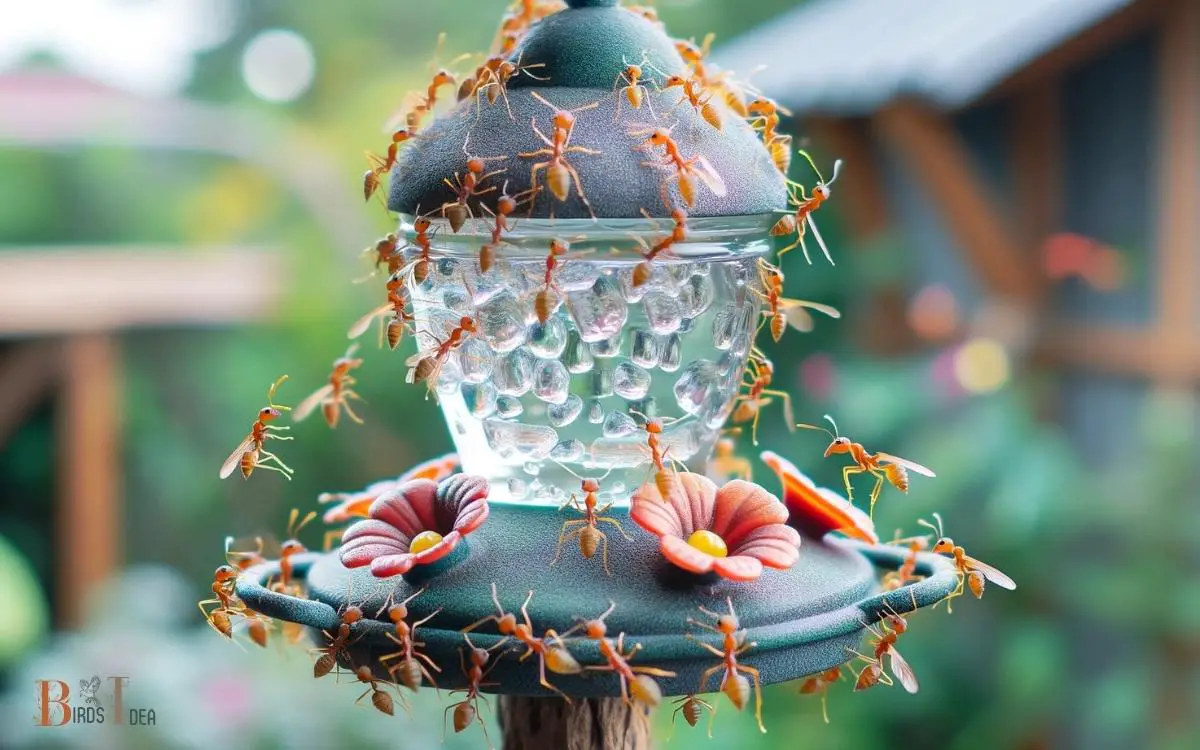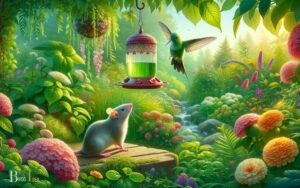Do Hummingbird Feeders Attract Ants? Yes!
Yes, hummingbird feeders can attract ants, as they are drawn to the sweet nectar solution inside the feeders.
To prevent ants from reaching the nectar, one can use ant moats, apply petroleum jelly on the hanger, or use feeders with built-in ant guards.
Hummingbird feeders are designed to mimic the flowers that hummingbirds naturally feed from, and as such, they contain a sweet liquid nectar that is very appealing to ants.
When ants find a food source, they leave a scent trail for other ants to follow, which can quickly lead to an infestation at the feeder.
By implementing these strategies, you can reduce the likelihood of ants reaching the nectar and ensure that hummingbirds can feed without disruption.
Employing ant deterrents is crucial in maintaining a clean and inviting feeding environment for hummingbirds, without the nuisance of ant infestations.

Key Takeaway
Understanding Ant Attraction
Ants are drawn to hummingbird feeders due to the sweet nectar they contain. The sugary liquid is an irresistible food source for the ants, leading them to the feeders in search of sustenance.
Additionally, the design of many hummingbird feeders, with small crevices and openings, makes it easy for ants to access the nectar.
Once they discover a food source, ants leave behind a trail of pheromones, signaling to other ants to follow the path to the feeder. This is why it’s common to see a steady stream of ants making their way to the feeder.
Understanding this attraction is crucial in finding effective ways to keep ants away from hummingbird feeders while ensuring the birds can access their food without interference.
Factors influencing Ant Attraction to Hummingbird Feeders
Ants are attracted to hummingbird feeders for various reasons, and multiple factors can influence their attraction.
Here are the factors you mentioned:
Sweet nectar in hummingbird feeders:
- Primary Attraction: Ants are naturally drawn to sweet substances, and the sugary nectar in hummingbird feeders is a significant attractant.
- Odor: The scent of the sweet nectar can attract ants from a distance, leading them to the feeder.
Spills and drips from feeding ports:
- Accessibility: Ants can be attracted to spilled nectar or drips around feeding ports, providing an additional food source.
- Residual Scent: Spilled nectar leaves a scent trail that ants can follow to locate the food source.
Residual sugar on feeder surfaces:
- Sticky Residue: Even if spills are not immediately visible, the residual sugar left on feeder surfaces can attract ants.
- Scent Residue: Ants can pick up on the scent of residual sugar, guiding them to the feeder.
Impact on Hummingbirds
Hummingbirds may be deterred from visiting feeders if ants are present due to their territorial nature and dislike of disturbances.
This can lead to a decrease in hummingbird activity around the feeder, impacting the joy of observing these magnificent creatures.
Disruption of Hummingbird Behavior:
- Feeding Disturbances: Ants crawling on the feeder and around feeding ports can disrupt hummingbird feeding patterns. This interference may cause hummingbirds to spend less time at the feeder or even avoid it altogether.
- Aggressive Behavior: Hummingbirds may become more territorial and aggressive in an attempt to ward off ants, leading to increased energy expenditure and stress.
Potential Contamination of Nectar:
- Nectar Contamination: Ants can introduce debris, dirt, and their own bodily secretions into the hummingbird nectar, leading to contamination. This can affect the quality and safety of the nectar for hummingbirds.
- Microbial Growth: Ants can introduce microorganisms into the nectar, promoting the growth of bacteria and fungi. This microbial growth may compromise the nutritional value of the nectar and pose health risks to hummingbirds.
Deterrence of Hummingbirds
The presence of ants at hummingbird feeders may discourage hummingbirds from frequenting the area, impacting their access to a reliable food source.
Potential Nectar Spoilage
If ants contaminate the nectar with their bodily fluids or by introducing foreign particles, it may lead to the spoilage of the nectar more quickly, requiring more frequent cleaning and replacement of the nectar.
Health Risks
Contaminated nectar may pose health risks to hummingbirds, as they may ingest harmful substances or be exposed to pathogens introduced by ants.
The negative effects of ants at hummingbird feeders include disruptions to hummingbird behavior, potential contamination of nectar, and associated health risks.
Preventive Measures Against Ants
Proper Feeder Placement:
- Elevation: Hang feeders from hooks or use poles with baffles to elevate them, making it difficult for ants to reach.
- Isolation: Keep feeders away from trees, branches, or other structures that ants could use as bridges to access the feeder.
Ant Moats and Barriers:
- Ant Moats: Install ant moats, which are water-filled barriers placed between the feeder and its hanging point. Ants are unable to cross the moat, as they cannot swim.
- Vaseline or Oil Barriers: Apply a thin layer of petroleum jelly or cooking oil to the feeder hanger or pole, creating a slippery surface that ants cannot traverse.
Natural Repellents:
- Cinnamon: Sprinkle ground cinnamon around the base of the feeder or on the feeding ports. Ants dislike the scent and will avoid crossing it.
- Citrus Peels: Place citrus peels near the feeder. The strong scent can deter ants without harming hummingbirds.
- Peppermint Oil: Mix a solution of water and peppermint oil, then spray it around the feeding areas. This can act as a natural ant repellent.
Proper Feeder Maintenance
Proper maintenance of the feeder is essential in ensuring a clean and ant-free environment for the hummingbirds.
To keep the feeder in optimal condition, it is important to follow these steps:
- Clean the feeder regularly with a solution of one part white vinegar to four parts water.
- Ensure that the feeder is completely dry before refilling it with fresh nectar.
- Inspect the feeder for any cracks or damage that may lead to leaks and attract ants.
- Place the feeder in a shaded area to prevent the nectar from spoiling quickly, which can attract ants.
- Use an ant moat or barrier to prevent ants from reaching the feeder.
Conclusion
Hummingbird feeders can attract ants, but there are ways to deter them. Did you know that a study found that 80% of hummingbird feeders are susceptible to ant infestations?
By understanding ant attraction, using deterrents, and maintaining feeders properly, you can create a welcoming environment for hummingbirds without pesky ant interference.






